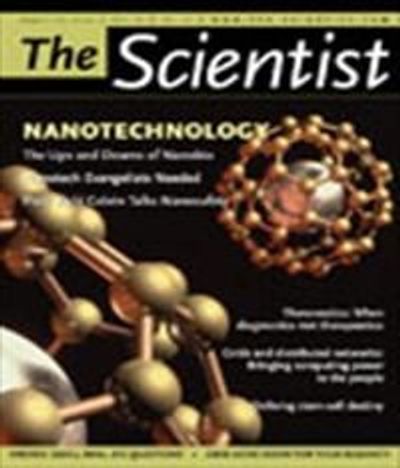© 2004 Cell Press
Brightfield images of hMSCs plated onto small 1,024 μm2 or large 10,000 μm2 fibronectin islands after 1 week in growth or mixed media. Lipids stain red, alkaline phosphatase stains blue. Scale bar = 50 μm. (From R. McBeath et al.,

Researchers have tried for years to make stem cells differentiate into specific cell types. This work usually involves bathing the cells in molecular signals that affect their fate. Some are finding, though, that cellular shape may be at least as influential as signal molecules in the differentiation process. This adds to a growing literature suggesting that cellular spatial structure affects many activities, including proliferation, apoptosis, and tumorigenesis.
Johns Hopkins University researchers found that shape and related characteristics of human mesenchymal stem cells (bone marrow cells that become fat, bone, cartilage, or muscle) are the strongest known...
MURKY DETAILS
The new study may also point to mechanisms for this commitment process. It seems a flattened shape stimulates ROCK, which tenses the cytoskeleton's actin fibers via the molecular motor myosin. The tension, or lack of it in balled-up cells, is a decisive factor in whether cells differentiate toward bone or fat respectively, the authors say. Further details are murky, but the study suggests tissue-engineering researchers should consider "what kinds of mechanical environment the cells are sitting in," and which molecular pathways are modulated by shape, says Christopher Chen, senior author and assistant professor of biomedical engineering and oncology at Johns Hopkins.
Mark Pittenger, vice president of research for Osiris Therapeutics, Baltimore, Md., says the findings could aid companies in developing cartilage replacement therapies for arthritis. "Growing cells to appropriate density," as in a part of Chen's study that involved crowding cells to force them into appropriate shapes, could help, says Pittenger.
Others say the findings add to growing evidence that the cytoskeleton serves as a lattice to bring together enzymes for many cellular activities. Gabor Forgacs, University of Missouri professor of biological physics, recently found that cytoskeletal and signaling proteins, such as those implicated in differentiation, associate together more often than any other classes of proteins in yeast.2
Disagreement surrounds just how this structure-signal dance works. Ingber espouses a theoretical explanation, called tensegrity, which has attracted both praise and criticism. Tensegrity proposes that the cytoskeleton is a set of tensed and compressed rods akin to structures built by the noted architect Buckminster Fuller. The theory also asserts that tension-induced rearrangements in this lattice affect biochemistry, a claim the latest findings "completely support," Ingber says. Forgacs, a skeptic, insists tensegrity can't explain the speedy movements of real cytoskeletons, but says either way, "I don't think anyone would seriously argue today that the cytoskeleton is not an important part of intracellular signaling."
Jack Lucentini
Interested in reading more?




